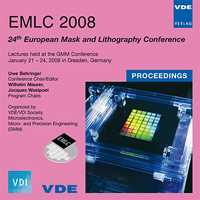Polarization-induced astigmatism caused by topographic masks
Konferenz: EMLC 2008 - 24th European Mask and Lithography Conference
21.01.2008 - 24.01.2008 in Dresden, Germany
Tagungsband: EMLC 2008
Seiten: 15Sprache: EnglischTyp: PDF
Persönliche VDE-Mitglieder erhalten auf diesen Artikel 10% Rabatt
Autoren:
Ruoff, Johannes; Neumann, Jens Timo; Geh, Bernd (Carl Zeiss SMT AG, D-73446 Oberkochen, Germany)
Schmitt-Weaver, Emil (ASML US, Inc., DE Adv. Lithogr. Appl. Research, 25 Corporate Circle, Albany, NY)
Setten, Eelco van; Masson, Nicolas le (ASML Netherlands B. V. de Run 6501, 5504 DR Veldhoven, The Netherlands)
Progler, Chris (Photronics Inc., 601 Millennium Drive, Allen, Texas)
Geh, Bernd (ASML US, Inc., 8555 S. River Parkway, Tempe, AZ)
Inhalt:
With the continuous shrink of feature sizes the pitch of the mask comes closer to the wave length of light. It has been recognized that in this case polarization effects of the mask become much more pronounced and deviations in the diffraction efficiencies from the well known Kirchhoff approach can no longer be neglected. It is not only the diffraction efficiencies that become polarization dependent, also the phases of the diffracted orders tend to deviate from Kirchhoff theory when calculated rigorously. This also happens for large structures, where these phase deviations can mimic polarization dependent wave front aberrations, which in the case of polarized illumination can lead to non-negligible focus shifts that depend on the orientation and the features size themselves. This orientation dependence results in a polarization induced astigmatism offset, which can be of the same order of magnitude or even larger as polarization effects stemming from the lens itself. Hence, for correctly predicting polarization induced astigmatism offsets, one has to both consider lens and mask effects at the same time. In this paper we present a comprehensive study of polarized induced phase effects of topographic masks and develop a simple theoretical model that accurately describes the observed effects.


